2004 年广东中山大学语言学概论考研真题
I.
1. elite
2. chimney
3. sacrifice
4.hierachry
5. agenda
6. chaotic
7.wrestle
8. pamphlet
9.Greenwich
10. amour
II.
1.sociolinguistics
2.complementary distribution
3. assimilation
4.case
5. contrastive
6.behaviourism
7. Relevance
8. The Meaning of Meaning
9. Noam Chomsky
�
10. potential
11.referential
12. Firth
13. proficiency
14.compositionality
15. J.R. Firth
III.
1. Prescriptive grammar is a grammar which states rules for what is considered the best or most
correct usage.
It is often based not on descriptions of actual usage but rather on the
grammarian’s views of what is best.
2. Back formation refers to an abnormal type of words-formation where a shorter word is
derived by deleting an imagined affix form a longer form already in the language.
in processing and
3. Psycholinguistics investigates the interrelation of language and mind,
It also studies language
producing utterances and in language acquisition for example.
development in the child, such as the theories of language acquisition; biological foundations of
language; and the relationship between language and cognition.
4. According to Sapir-Whorf hypothesis, language determines our thinking patterns; similarity
between languages is relative, the greater their structural differentiation is, the more diverse
their conceptualization of the world is. This is referred to as linguistic relativity.
5. The term phatic communion originates from Malinowski’s study of the functions of language.
It refers to the social
interaction of language. We all use small, seemlingly meaningless
expressions to maintain a comfortable relationship between people without involving any factual
content. Ritual exchanges about health or weather often state the obvious phatic communion.
6. Traditional grammar is a grammar that is usually based on earlier grammars of Latin or Greek.
It is often notional and prescriptive in their approach.
7. Those words that express grammatical meanings, such as, conjunctions, prepositions, articles,
and pronouns, are grammatical words.
8. In systemic-functional grammar, theme is the element which serves as the point of departure
of the message; it is that with which the clause is concerned.
�
9. The cooperative principle proposed by Paul Grice follows as such: make your conversational
contribution such as is required, at the stage at which it occurs, by the accepted purpose or
direction of the talk exchange in which you are engaged.
10. Hyponymy refers to the sense relationship between a more general, more inclusive and a
more specific word. The word which is more general in meaning is called the superordiante, and
the more specific words are called its hyponyms.
IV.
1. The widely accepted designing feature of arbitrariness refers to the fact that the forms of
linguistic signs bear no natural relationship to their meaning. For instance, we cannot explain
why a book is called a /buk/ and a pen a /pen/. The arbitrary nature of language is a sign of
sophistication and it makes it possible for language to have an unlimited source of expressions.
The link between a linguistic sign and its meaning is a matter of convention. Here we have to
look at the other side of the coin of arbitrariness, namely, conventionality. Arbitrariness of
language makes it potentially creative, and conventionality of language makes learning a
language laboring. For learners of a foreign language, it is the conventionality of a language that
is more worth noticing than its arbitrariness.
2. Chomsky’s innateness hypothesis is based on his observations that some important facts can
never be otherwise explained adequately. First, children learn their native language fast and with
little effort. It is said that children become fluent speakers of their native language by the age of
five. Considering the fact that small children are not yet intellectually mature for any other
sciences, this is surprising fast. Second, there are other facts that are puzzling if language is not
innate. Children learn their mother tongue in very different environments. But they follow more
or less the same stages in acquisition: the babbling stage, nonsense word stage, holophrastic
stage, two –word utterance, developing grammar, near-adult grammar, and full competence.
Despite the great difference in linguistic environment, they reach uniform levels of competence.
Children may be good at different things. But in their first language acquisition, their difference
is amazingly small. Third, the child learns the total grammar of the language during a limited
period of time, from limited exposure to speech (which is often degenerate data). He can not
only produce and understand sentences he has heard, but also sentences he has never heard
before. What he learns seems to be set of rules rather than individual sentences.
All these suggest that although babies are not born knowing a language, they are born with a
predisposition to develop a language in much the same way as they are born with a
predisposition to leaner to walk. Like the ability to walk, the ability to speak and understand
spoken langue seems to be a natural human activity.
3. The interpersonal function embodies all uses of language to express social and personal
relations. This includes the various ways the speaker enters a speech situation and performs a
speech act. Because the clause is not confined to the expression of transitivity, there are
non-ideational elements in the adult language system. These elements are grouped together as
�
this metafunction in the grammar covering a whole range of particular uses of language.
Interpersonal function is realized by MOOD and MODALITY. MOOD shows what role the speaker
selects in the speech situation and what role he assigns to the addressee. If the speaker selects
the imperative mood, for example, he assumes the role of one giving commands and puts the
addressee in the role of one expected to obey orders. MODALITY specifies if the speaker is
expressing his judgment or making a prediction. For example, Give me that teapot.
V.
The study of speech sounds is partitioned between two distinct but related disciplines,
1.
phonetics and phonology. Phonetics studies how speech sounds are made, transmitted and
received. Phonology is the study of the sound systems of language. There is a fair degree of
overlap in what concerns the two subjects. Phonology is concerned with the linguistics
patterning of sounds in human language, with its primary aim being to discover the principles
that govern the way sounds are organized in language, and to explain the variations teat occur.
The human vocal apparatus can produce a very wide range of sounds but only a small number of
these are used in a language to construct all of is words and sentences. Phonetics is the study of
all possible speech sounds while phonology studies the way in which speakers of a language
systematically use a selection of these sounds in order to express meaning.
Phonology is not specifically concerned with aspects of speech production or perception as
these are purely the result of the physical properties of the system. In the study of coarticualtion
in English, for example, it is often said that the articulation of the [t] sounds in the words tea and
too differ from each other slightly. Phoneticians are concerned with how these two [t]’s differ in
the way they are pronounced while phonologists are interested in the patterning of such sounds
and the rules that underlies such variations.
2. With the development of transformational-generative grammar and other linguistic theories,
some changes of attitudes have taken place. First of all, the nature of language is views
differently—learning a language involves making constant hypotheses about the structure of the
target language. The learner tests his now hypothesis against what the native speaker says. The
errors he makes are actually his incorrect hypotheses about the new language. Another linguistic
system based on the observation output which results from a learner’s attempted production of
a target language form. Interlanguage is formed when the learner attempts to learn a new
language, and it has features of both the first and the second language but it neither,
The post-structuralists, therefore, regard errors as evidence of the learning process by making
hypothesis about target language; the learner arrives at a particular interlanguage. Then he
modifies his hypothesis and goes on towards the target language. Obviously, errors can be found
at the stage of interlanguage. As stated by Corder, errors are significant in three different ways:
a. They tell the teacher, if he undertakes a systematic analysis, how far towards the goal the
learner has progressed and consequently when remains for him to learn.
�
b. They provide the researchers with evidence of how language is learned or acquired, what
strategies or procedures the learner is employing in his discovery of the language.
c. They are indispensable to the learner himself, because we can regard the making of errors
as a device the learner uses in order to learn. It is a way the learner has of testing his hypothesis
about the nature of the language he is learning. The making of errors then is a strategy
employed both by children acquiring their mother tongue and adults learning a second
language.
3.
Chomsky believes that langue is somewhat innate, and that children are born with what he
calls a langue acquisition device (LAD), which is a unique kind of knowledge that fits them for
language learning. He argues the child comes into the world with specific innate endowment,
not only with general tendencies or potentialities, but also with knowledge of the nature of the
world, and specifically with knowledge of the nature of language. According to his view, children
are born with knowledge of the basic grammatical relations and categories, and this knowledge
is universal. The categories and relationship exist in al human languages and all human infants
are born with knowledge of them. According to him, the study of langue, or the structure of
langue, can throw some light on the nature of the human mind. This approach to language is a
reaction against behaviorisms in psychology and empiricism in philosophy, making linguistics a
branch of psychology.
Halliday has inherited the idea that langue is a social phenomenon, and emphasizes the study of
language in relation to the functions it performs. In his opinion, “ Language, in its primitive
functions, [is] to be regarded as a mode of action, rather than as a countersign of thought ”.
Language originally“was never used as a mere mirror of reflected thought.”In its primitive use,
language functions as a link in concerted human activity, as a piece of human behavior,. It is a
mode of action and not an instrument of reflection. Halliday regards meaning as primary above
the grammar, thus seeing language as “meaning potential”. Halliday also has classified three
metafunctions of language “ ideational, interpersonal, and textual”, and related the functions
of language to its structures, which are transitivity, mood and theme respectively.
�
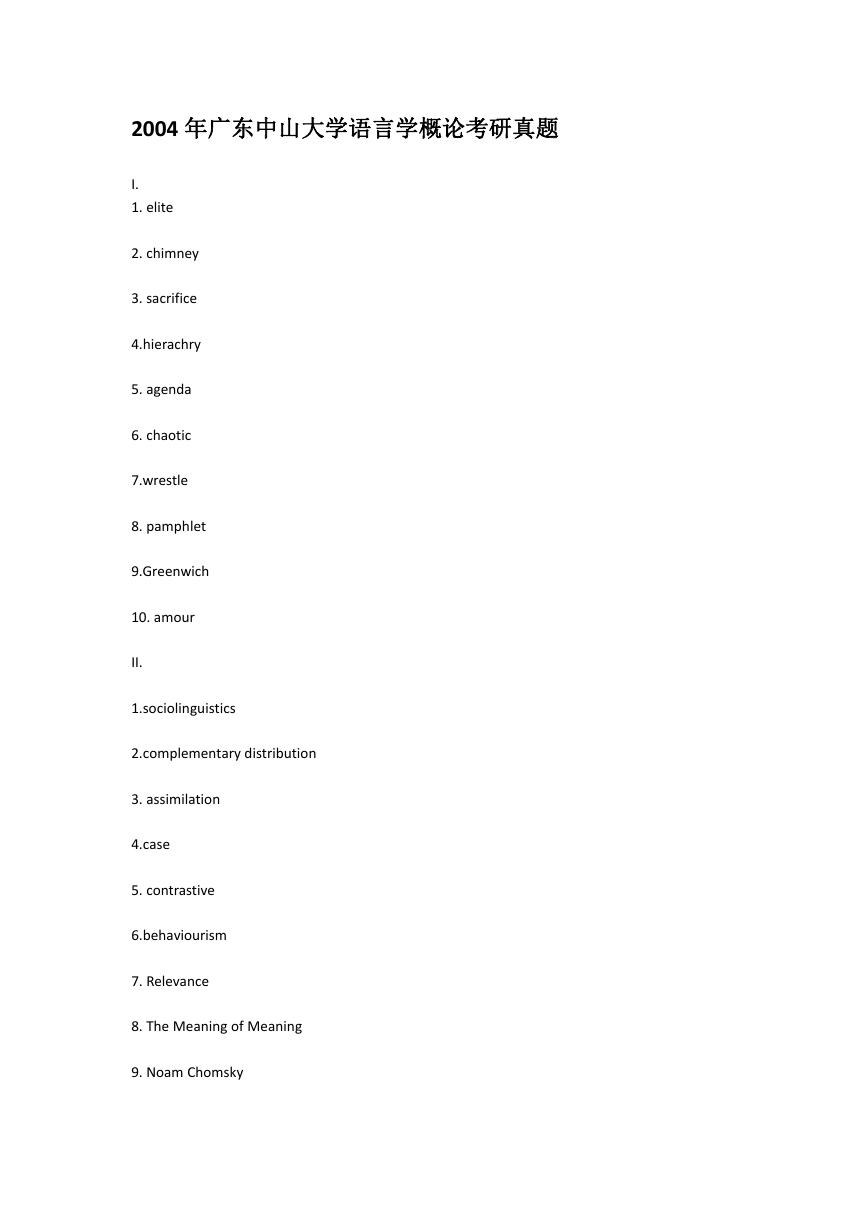
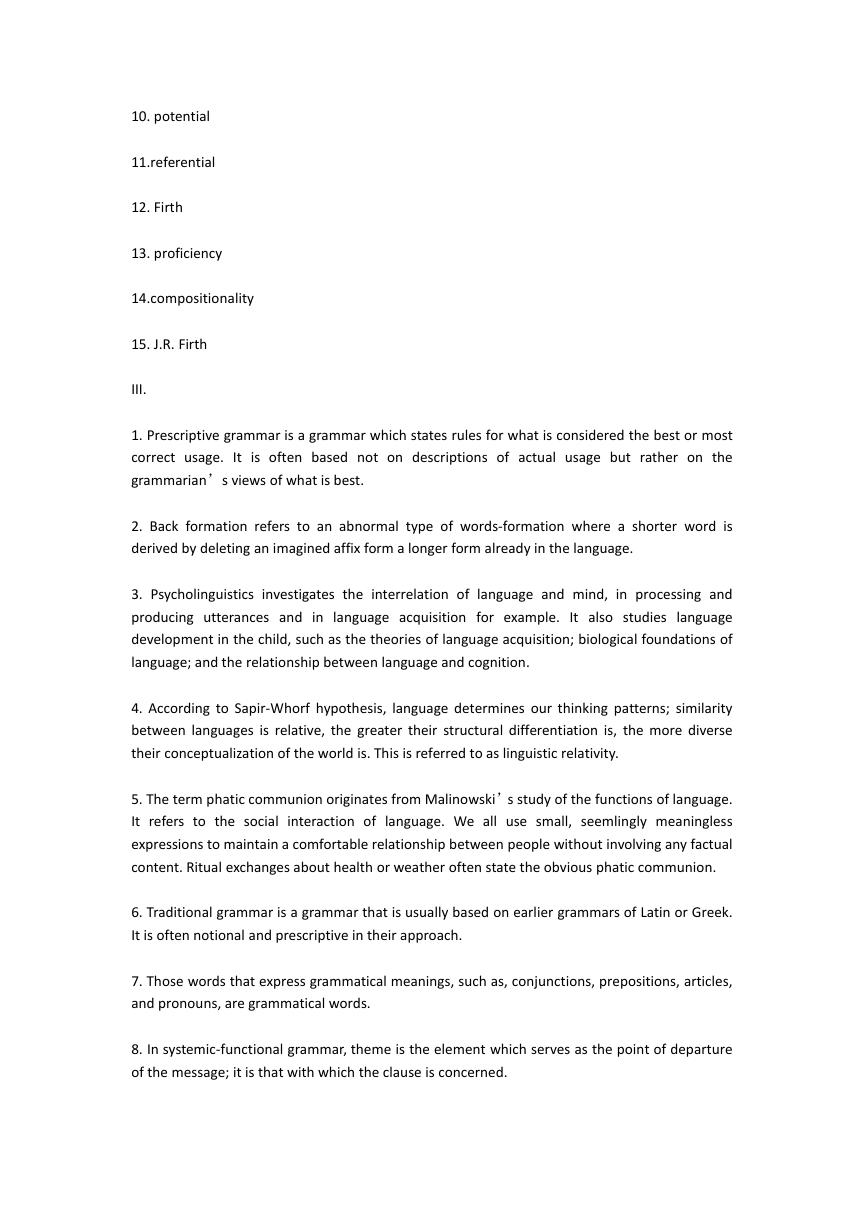
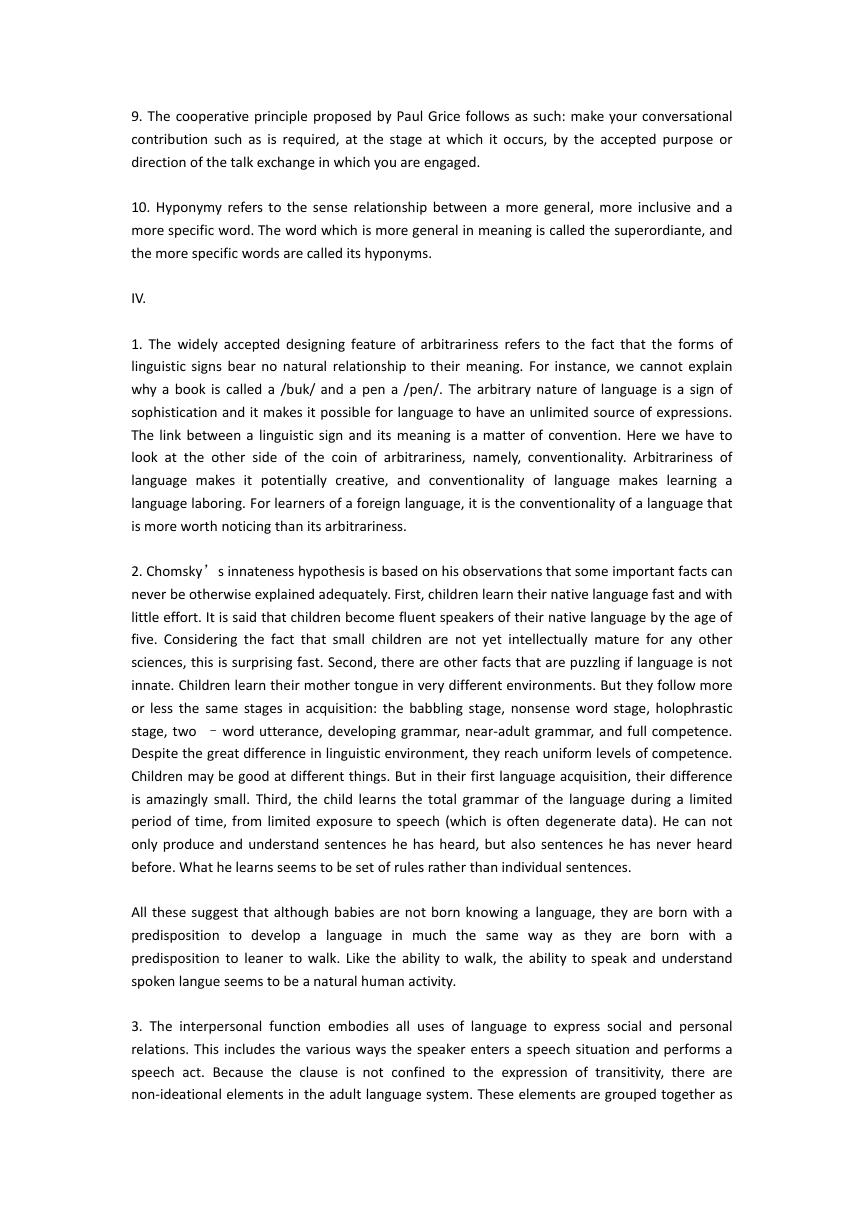
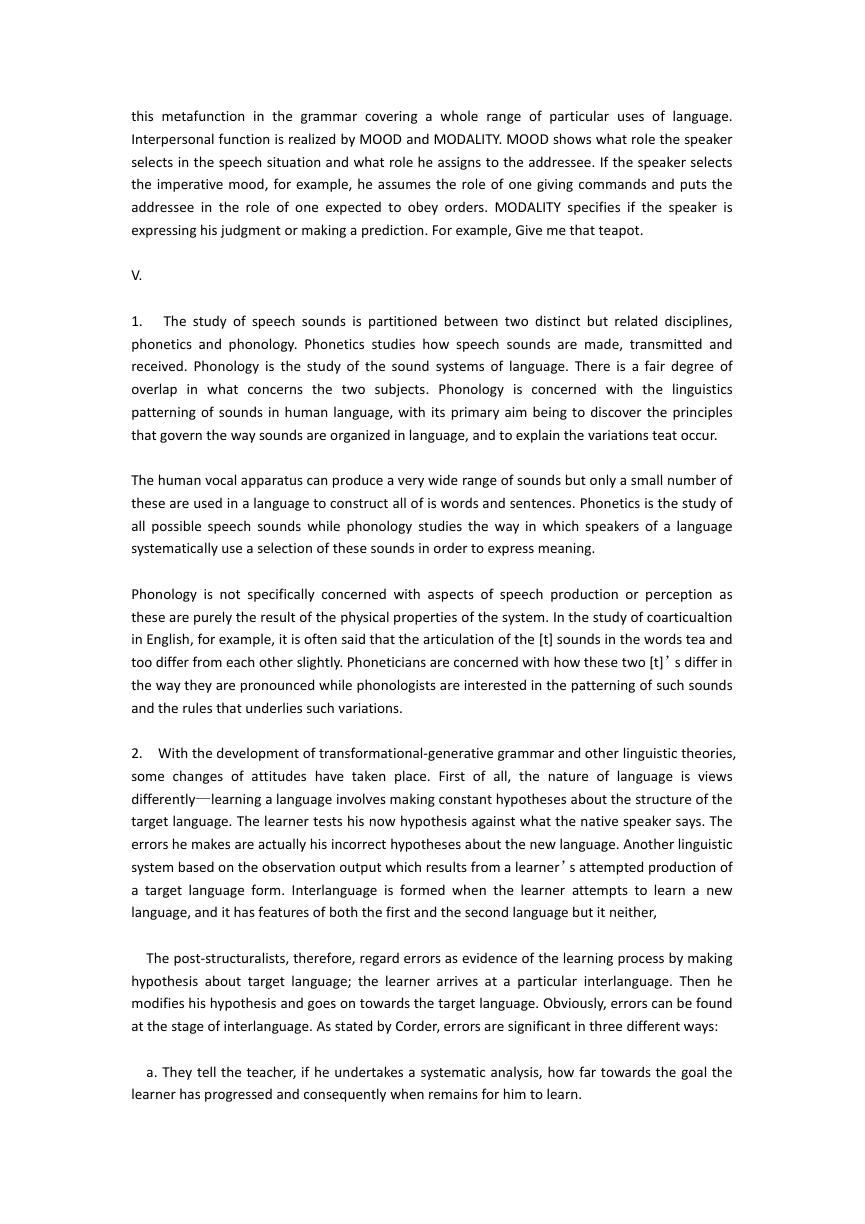
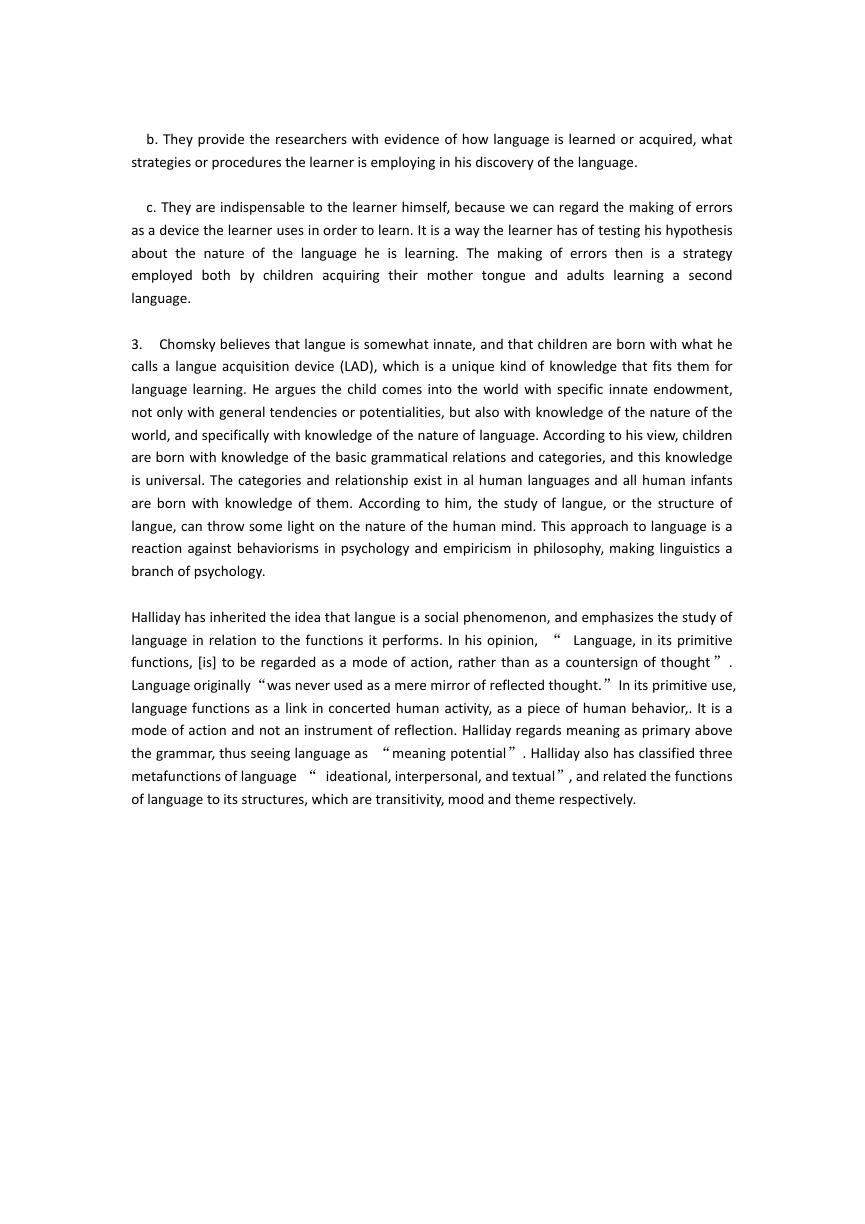





 2023年江西萍乡中考道德与法治真题及答案.doc
2023年江西萍乡中考道德与法治真题及答案.doc 2012年重庆南川中考生物真题及答案.doc
2012年重庆南川中考生物真题及答案.doc 2013年江西师范大学地理学综合及文艺理论基础考研真题.doc
2013年江西师范大学地理学综合及文艺理论基础考研真题.doc 2020年四川甘孜小升初语文真题及答案I卷.doc
2020年四川甘孜小升初语文真题及答案I卷.doc 2020年注册岩土工程师专业基础考试真题及答案.doc
2020年注册岩土工程师专业基础考试真题及答案.doc 2023-2024学年福建省厦门市九年级上学期数学月考试题及答案.doc
2023-2024学年福建省厦门市九年级上学期数学月考试题及答案.doc 2021-2022学年辽宁省沈阳市大东区九年级上学期语文期末试题及答案.doc
2021-2022学年辽宁省沈阳市大东区九年级上学期语文期末试题及答案.doc 2022-2023学年北京东城区初三第一学期物理期末试卷及答案.doc
2022-2023学年北京东城区初三第一学期物理期末试卷及答案.doc 2018上半年江西教师资格初中地理学科知识与教学能力真题及答案.doc
2018上半年江西教师资格初中地理学科知识与教学能力真题及答案.doc 2012年河北国家公务员申论考试真题及答案-省级.doc
2012年河北国家公务员申论考试真题及答案-省级.doc 2020-2021学年江苏省扬州市江都区邵樊片九年级上学期数学第一次质量检测试题及答案.doc
2020-2021学年江苏省扬州市江都区邵樊片九年级上学期数学第一次质量检测试题及答案.doc 2022下半年黑龙江教师资格证中学综合素质真题及答案.doc
2022下半年黑龙江教师资格证中学综合素质真题及答案.doc